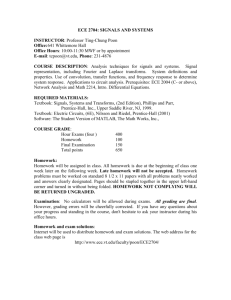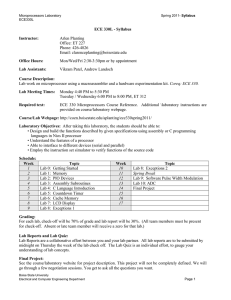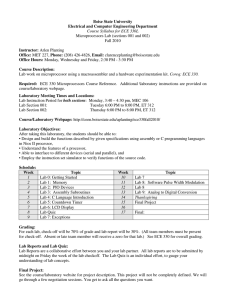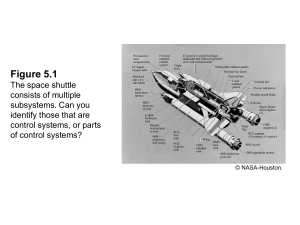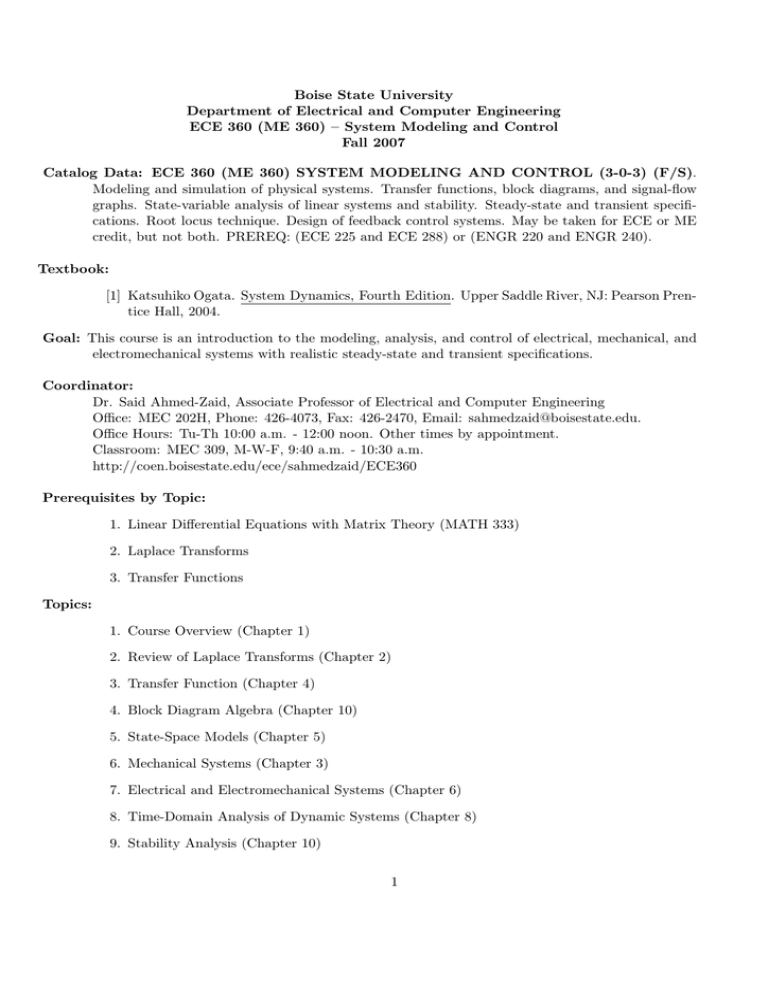
Boise State University
Department of Electrical and Computer Engineering
ECE 360 (ME 360) – System Modeling and Control
Fall 2007
Catalog Data: ECE 360 (ME 360) SYSTEM MODELING AND CONTROL (3-0-3) (F/S).
Modeling and simulation of physical systems. Transfer functions, block diagrams, and signal-flow
graphs. State-variable analysis of linear systems and stability. Steady-state and transient specifications. Root locus technique. Design of feedback control systems. May be taken for ECE or ME
credit, but not both. PREREQ: (ECE 225 and ECE 288) or (ENGR 220 and ENGR 240).
Textbook:
[1] Katsuhiko Ogata. System Dynamics, Fourth Edition. Upper Saddle River, NJ: Pearson Prentice Hall, 2004.
Goal: This course is an introduction to the modeling, analysis, and control of electrical, mechanical, and
electromechanical systems with realistic steady-state and transient specifications.
Coordinator:
Dr. Said Ahmed-Zaid, Associate Professor of Electrical and Computer Engineering
Office: MEC 202H, Phone: 426-4073, Fax: 426-2470, Email: sahmedzaid@boisestate.edu.
Office Hours: Tu-Th 10:00 a.m. - 12:00 noon. Other times by appointment.
Classroom: MEC 309, M-W-F, 9:40 a.m. - 10:30 a.m.
http://coen.boisestate.edu/ece/sahmedzaid/ECE360
Prerequisites by Topic:
1. Linear Differential Equations with Matrix Theory (MATH 333)
2. Laplace Transforms
3. Transfer Functions
Topics:
1. Course Overview (Chapter 1)
2. Review of Laplace Transforms (Chapter 2)
3. Transfer Function (Chapter 4)
4. Block Diagram Algebra (Chapter 10)
5. State-Space Models (Chapter 5)
6. Mechanical Systems (Chapter 3)
7. Electrical and Electromechanical Systems (Chapter 6)
8. Time-Domain Analysis of Dynamic Systems (Chapter 8)
9. Stability Analysis (Chapter 10)
1
10. Controller Design (Chapter 10)
11. Three Hour Exams (3 hours)
Assignments and Computer Usage:
1. Homework will be assigned weekly and consists of exercises, problems and MATLAB problems. Homework will be collected at the beginning of each lecture. Usually, the solutions
will be handed out at the next lecture following the homework due date. You will not be
penalized if you hand in a late homework at that time. However, homework submitted after
the solutions have been handed out will not count.
2. A control system design project will be assigned during the course. Team cooperation will
be allowed for the realization of the projects. The project will make extensive use of MATLAB/SIMULINK and the Control System Toolbox.
3. An educational control system (inverted pendulum or magnetic levitation system) will be
available for the demonstration of a computer-controlled control system.
Grading Policy:
Homework
Three Exams
Design Project
Final
Total
15%
45%
15%
25%
100%
2
Learning Objectives:
After taking this course, you will be able to:
1. To solve ordinary differential equations using Laplace transforms.
2. To model and analyze a linear system in the frequency domain by reducing a complex multiblock control system to a standard form using block diagram algebra; deriving the input-tooutput transfer function; and computing the impulse response, output response and steadystate error for a given test input signal.
3. To model and analyze a linear system in the time domain by deriving its state equations;
drawing the signal-flow graph; deriving the input-to-output transfer function using Mason’s
rule; computing the characteristic roots; and assessing the stability of the system from the
location of these roots in the complex domain using the Routh-Hurwitz (R-H) stability criterion.
4. To model electrical, mechanical, and electromechanical systems using state-space variables
in the time domain and to solve the state equations for standard inputs (step response or
impulse response).
5. To evaluate the time-domain performance of control systems by computing steady-state errors; determining the dominant roots; computing performance measures; and determining
admissible stability regions.
6. To design and tune a three-term (PID) controller for a physical system to achieve desired
steady-state and transient specifications.
3

